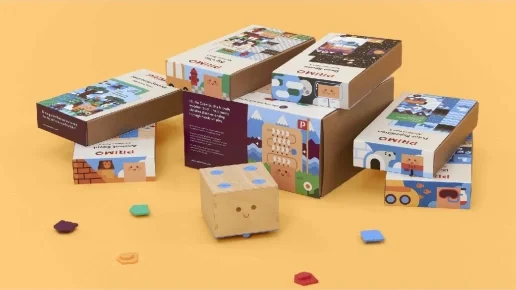Toy packaging is the first thing children and parents notice when they see a toy. It keeps the toy safe, makes it look exciting, and helps brands stand out in stores or online.
The design also plays an equally important role. From bright colors and fun shapes to clear safety information, good toy packaging boxes combine protection, creativity, and branding.
Why Packaging Matters for Toys
- Protection: Toys need safe packaging so they don’t break or get damaged while being shipped or displayed.
- Attraction: Bright and fun packaging attract kids and also helps parents notice it quickly.
- Branding: Packaging shows the brand’s style, values, and trust. It helps parents choose toys from brands they know and love.
In this blog, I’ll discuss the importance of toy packaging design, its key elements, design trends, and unique styles.
Importance of Toy Packaging Design
Toy packaging is a powerful tool that:
- Keeps toys safe from dust, damage, or tampering.
- Makes toys look fun and appealing.
- Shares important information like age limits, warnings, and instructions.
- Supports branding and marketing by making toys recognizable.
- Creates excitement when kids unbox the toy, adding to their overall experience.
Key Elements of Toy Packaging Design
- Bright colors and visuals
Toys packaging with bold colors, cartoon images, and playful designs grabs attention in stores and online.
- Windows for Product Visibility
See-through windows or cut-outs let kids view the toy before buying. It builds trust and helps buyers know what they are getting.
- Age-appropriate Designs
Toy packaging must match the age group. For toddlers, simple graphics and soft colors work best. For older kids, bold designs, characters, and trendy themes are more attractive.
- Clear Instructions and Warnings
Labels like “Choking hazard” or “For ages 3+” build trust. Simple setup instructions also make the toy easy to use.
- Eco-friendly Choices for Brands
Many parents prefer eco-friendly toy packaging. Using recyclable cardboard, paperboard, or biodegradable pouches reduces waste and supports sustainability.
Common Styles of Toy Packaging
- Folding Carton boxes
These lightweight boxes are popular for small to medium-sized toys. They are easy to print on, eco-friendly, and cost-effective.
- Rigid boxes for Premium Toys
Premium toys like collector dolls or board games often use rigid boxes. They are sturdy, stylish, and perfect for gift-worthy packaging.
- Window Boxes
These boxes have PVC windows so customers can see the toy without opening them. It is common for dolls, cars, and action figures.
- Blister Packs and Clamshells
These are plastic molds that tightly hold toys in place. They are often used for small toys, accessories, or collectibles.
- Drawer Boxes for Collectible Toys
Drawer-style boxes slide open like a tray. They feel premium and are perfect for collectible or limited-edition toys.
- Mailer boxes for E-Commerce toys
With more toys sold online, mailer boxes are popular. They are sturdy, easy to assemble, and designed to protect toys during shipping.
Materials Used in Toy Packaging
- Cardboard and Paperboard
The most common materials, cardboard and paperboard, are lightweight, durable, and recyclable.
- Kraft Paper for Eco-Friendly Packaging
Kraft paper is durable, natural, and biodegradable. It’s a great option for brands that focus on sustainability.
- Plastic (Blister, Clamshell, PET)
Plastic is used for protective packaging like blister packs. PET plastic is popular because it is recyclable.
- Recyclable and Biodegradable Options
Many toy brands use biodegradable films, recycled cardboard, and eco-inks to reduce environmental impact.
Design Trends in Toy Packaging
- Minimalist Design with Simple Graphics
Clean and simple packaging with fewer colors, designs, and typography is becoming popular.
- Interactive Packaging
Packaging that can be reused as coloring sheets, puzzles, or small games keeps kids engaged and reduces waste.
- Gender-Neutral Packaging
Gender-neutral packaging uses colors, designs, and styles that appeal to all children to reach wider audience.
- Sustainable and Reusable Toy Packaging
Some toy packaging is designed to be reused as storage boxes, dollhouses, or craft materials, making it reusable.
Interactive Features in Toy Packaging
Interactive toy packaging adds value for kids and parents.
Examples include:
- Packaging that turns into playsets.
- Hidden surprise compartments.
- QR codes linking to games, stories, or tutorials.
- Coloring sections on the box.
- Spinning pieces or buttons that makes sound for an engaging experience.
This makes the unboxing part of the play experience.
Importance of Sustainability in Toy Packaging
- Rising Demand for Eco-Friendly Packaging
Parents are more eco-conscious and choose brands that care about the planet. Eco-packaging attracts these buyers.
- How Brands Reduce Waste with Toy Packaging
Brands use fewer plastics, switch to recycled cardboard, and design packaging that doubles as storage.
Examples of Recyclable and Reusable Toy Boxes
- Lego uses paper bags inside boxes instead of plastic.
- Some doll brands make boxes that convert into dollhouses.
- Cardboard boxes are designed to be folded into puzzles or art projects.
Toy Packaging Design by Age Group
- Toddlers (1–3 years): Soft colors, large fonts, safe designs, and clear safety labels.
- Preschoolers (4–6 years): Bright colors, cartoon characters, and interactive packaging.
- Kids (7–10 years): Bold themes, fun graphics, and trend-based designs.
- Pre-teens & Collectors (11+): Premium packaging, drawer boxes, and storytelling elements.
Design must always match the child’s age to ensure both safety and appeal.
Conclusion
Toy packaging design protects toys, shares safety details, attracts kids, and supports branding. From folding cartons to premium rigid boxes, packaging styles are chosen based on the toy’s purpose and audience.
Modern toy packaging is shifting toward eco-friendly, interactive, and storytelling designs. Parents want safety, sustainability, and that also creates excitement for kids.
In short, toy packaging design is not just about wrapping a toy; it is about creating a full experience that begins the moment a child sees the box.

